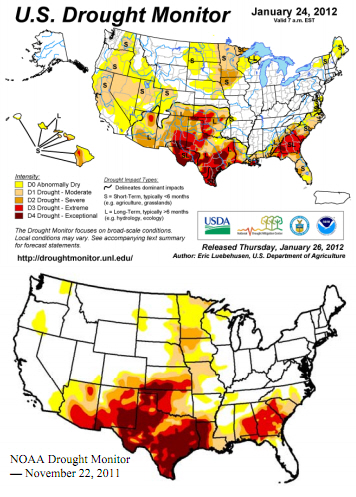



CME: Is Drought Still a Problem?
US - How dry does it have to get for a major newspaper, even one with an agricultural heritage, to devote above-the-fold coverage using two-thirds of the front page of a Sunday edition to a drought that is really not causing any harm at the moment, write Steve Meyer and Len Steiner. We
think the answer is “Pretty dry!” because it just happened this weekend in Des Moines, Iowa when the venerable Des Moines Register
devoted that space PLUS 1.5 pages inside the A Section PLUS another page in the Business/Agriculture section to very dry conditions
in northwest Iowa. And the dry conditions do not stop at the state line.
As can be seen in the map below, a large area of northwest Iowa and southern Minnesota are classified as severe drought
areas. USDA/NOAA (National Oceanic and Atmospheric Administration) still classify the area as “Short-term” drought but much of it will
soon reach 6-months since the last significant precipitation fell and
rivers, streams and wells in the area are showing signs of a severe
hydrological shortage. As can be seen by comparing to top map to
the bottom one from November 22, 2011, conditions have generally
improved in the western Cornbelt over the winter months as dry areas
in eastern Kansas, Missouri, southeast Nebraska and southern Iowa
have received some much-needed rainfall. The eastern Cornbelt
remains in good shape from a moisture standpoint.
But the situation in northwest Iowa and southern Minnesota,
which encompasses some of the most productive corn and soybean
land in the nation, is serious and, according to the National Weather
Service in the Register story, likely to get worse by April . NOAA’s
Seasonal Drought Outlook (go to http://www.cpc.ncep.noaa.gov/
index.php and click on Drought Outlook in the US Drought Assessment section) says that the western Cornbelt dryness will persist
through that time period and will spread to eastern Nebraska. It also
shows continuing (and spreading) areas of drought in the southwest
and southeast—bad news for cattlemen.
The Iowa-Minnesota situation even has experts mentioning
one very scary year from the past — 1988. The Register quotes Iowa
State’s Dr. Elwyn Taylor pointing out that the weather conditions this
year are nearly identical to those of 1988 when the last significant
drought hit Iowa and other major corn producing areas. Taylor does
point out that they are happening earlier this year so there is more
time to get rainfall before critical summer periods arrive.
Even the mention of 1988 makes market watchers cringe,
though. Iowa’s average corn yield in 1988 was 84 bushels per acre,
down from 130 in 1987 and 135 in 1986 and 24% below the average
of the prior 10 years. Minnesota’s was 74 bushels per acre, down
from 127 in ‘87 and 122 in ‘86. The national yield in 1988 was 84.6
bushels per acre, over 25 bushels lower than the year before and
26% lower than the 1960-2010 trend yield for 1988 of 113.9 bushels
per acre. The U.S. average farm price for corn went from $1.94/bu.
in ‘87-’88 all the way to $2.54 in ‘88-’89 but we must remember that
carryout stocks in the fall of 1987 were 4.259 billion bushels.
This year they are projected to be 846 million, one-fifth as large.
Taylor believes the culprit is La Nina, the cooling of Pacific
Ocean waters west of South America, that began in 2010. The early
stages of LaNina drove wetter-than-normal conditions in ‘10 and ‘11
but the latter stages usually cause dry conditions in the Midwest. If
LaNina remains through the spring, Taylor estimates that there is only
a 1 in 20 chance of getting enough spring rainfall in Iowa.
So what does this mean? Maybe nothing. Spring rains
could come and allay all of this concern and fear. The Cornbelt,
though, has not seen significant drought in January since 2006 when
conditions in a swath of southern Iowa and northern Illinois were classified as moderate to severe. We — and the markets — are accustomed to entering planting season with PLENTY of subsoil moisture
and thus some ability for the crop to survive short dry spells. Not so
this year for the areas noted here. We also know that today’s corn
varieties are more drought tolerant and will not likely fall 26% short of
trend yields even if 1988 conditions develop. But any degree of crop
shortage is scary when one begins year with very tight corn stocks.












